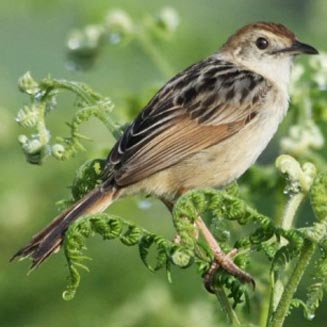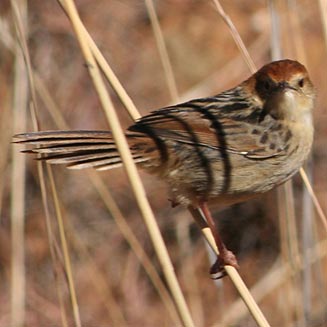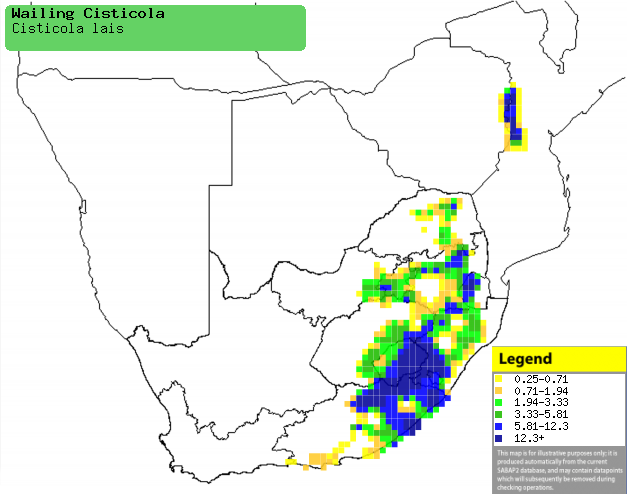|
Cisticola lais (Wailing cisticola)
Huiltinktinkie [Afrikaans]; Iqobo , Igqobo [Xhosa]; uQoyi
[Zulu]; Kadhi-idhi-i, Timba (generic names for cisticola) [Shona]; Ngonhavarimi
[Tsonga]; jammergraszanger [Dutch]; Cisticole plaintive [French];
Trauerzistensänger [German]; Fuinha-chorona [Portuguese]
Life
> Eukaryotes >
Opisthokonta
> Metazoa (animals) >
Bilateria >
Deuterostomia > Chordata >
Craniata > Vertebrata (vertebrates) > Gnathostomata (jawed
vertebrates) > Teleostomi (teleost fish) > Osteichthyes (bony fish) > Class:
Sarcopterygii (lobe-finned
fish) > Stegocephalia (terrestrial
vertebrates) > Tetrapoda
(four-legged vertebrates) > Reptiliomorpha > Amniota >
Reptilia (reptiles) >
Romeriida > Diapsida > Archosauromorpha > Archosauria >
Dinosauria
(dinosaurs) > Saurischia > Theropoda (bipedal predatory dinosaurs) >
Coelurosauria > Maniraptora > Aves
(birds) >
Order: Passeriformes > Family: Cisticolidae
> Genus: Cisticola
 |
 |
|
Wailing cisticola, Cedara Farm, Pietermaritzburg,
South Africa.[photo Alan Manson
©] |
Wailing cisticola, Golden Gate national park.
South Africa. [photo
Mauritz Peller ©] |
For information about this species, see
www.birdforum.net/opus/Wailing_Cisticola
Distribution and habitat
Although it has an isolated population in Angola, the bulk
of its distribution lies from southern Tanzania through Zambia, Malawi and
northern Mozambique to southern Africa. Here it occurs in Zimbabwe's eastern
highlands and South Africa, preferring montane grassland with bracken (Pteridium)
and shrubland or tall grassland on rocky hills.
|
 |
|
Distribution of Wailing cisticola in southern Africa,
based on statistical smoothing of the records from first SA Bird Atlas
Project (©
Animal Demography unit, University of
Cape Town; smoothing by Birgit Erni and Francesca Little). Colours range
from dark blue (most common) through to yellow (least common).
See here for the latest distribution
from the SABAP2. |
Brood parasites
It has been recorded as host of the
Brown-backed honeyguide.
Food
It ears a variety of invertebrates, doing most of its
foraging in dense undergrowth with grass and shrubs. The following food items have been recorded
in its diet:
Breeding
- The nest is ball-shaped with a side entrance, built of dry grass secured
with spider web and lined with plant down. It is typically placed in the
middle of a shrub or more often in a grass tuft, the leaves of which are
sometimes enmeshed in the nest.
- Egg-laying season is from September-March, peaking from
December-January.
- It lays 2-4 white to pale greenish blue eggs.
Threats
Not threatened.
References
-
Hockey PAR, Dean WRJ and Ryan PG 2005. Roberts
- Birds of southern Africa, VIIth ed. The Trustees of the John Voelcker
Bird Book Fund, Cape Town.
|
